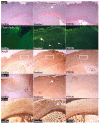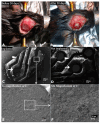A Polymer Thick Film on an Organic Substrate Grid Electrode and an Open-Source Recording System for UHF MRI: An Imaging Study
- PMID: 39204909
- PMCID: PMC11359886
- DOI: 10.3390/s24165214
A Polymer Thick Film on an Organic Substrate Grid Electrode and an Open-Source Recording System for UHF MRI: An Imaging Study
Abstract
Electrocorticography (ECoG) is a critical tool in preclinical neuroscience research for studying global network activity. However, integrating ECoG with functional magnetic resonance imaging (fMRI) has posed challenges, due to metal electrode interference with imaging quality and heating around the metallic electrodes. Here, we introduce recent advancements in ECoG grid development that utilize a polymer-thick film on an organic substrate (PTFOS). PTFOS offers notable advantages over traditional ECoG grids. Firstly, it significantly reduces imaging artifacts, ensuring minimal interference with MR image quality when overlaying brain tissue with PTFOS grids. Secondly, during a 30-min fMRI acquisition, the temperature increase associated with PTFOS grids is remarkably low, measuring only 0.4 °C. These findings suggest that utilizing ECoG with PTFOS grids has the potential to enhance the safety and efficacy of neurosurgical procedures. By providing clearer imaging results and mitigating risk factors such as excessive heating during MRI scans, PTFOS-based ECoG grids represent a promising advancement in neurosurgical technology. Furthermore, we describe a cutting-edge open-source system designed for simultaneous electrophysiology and fMRI. This system stands out due to its exceptionally low input noise levels (<0.6 V peak-to-peak), robust electromagnetic compatibility (it is suitable for use in MRI environments up to 9.4 teslas), and the inclusion of user-programmable real-time signal-processing capabilities. The open-platform software is a key feature, enabling researchers to swiftly implement and customize real-time signal-processing algorithms to meet specific experimental needs. This innovative system has been successfully utilized in several rodent EEG/fMRI studies, particularly at magnetic field strengths of 4.7 and 9.4 teslas, focusing on the somatosensory system. These studies have allowed for detailed observation of neural activity and responses within this sensory system, providing insights that are critical for advancing our understanding of neurophysiological processes. The versatility and high performance of our system make it an invaluable tool for researchers aiming to integrate and analyze complex datasets from advanced imaging and electrophysiological recordings, ultimately enhancing the depth and scope of neuroscience research.
Keywords: 4.7 teslas; 9.4 teslas; ECoG; MRI heating; artifacts; magnetic resonance imaging; open-access software; rats; recording system.
Conflict of interest statement
The authors declare no conflicts of interest.
Figures















References
-
- Ahmadi E., Katnani H.A., Besheli L.D., Gu Q., Atefi R., Villeneuve M.Y., Eskandar E., Lev M.H., Golby A.J., Gupta R., et al. An Electrocorticography Grid with Conductive Nanoparticles in a Polymer Thick Film on an Organic Substrate Improves CT and MR Imaging. Radiology. 2016;280:595–601. doi: 10.1148/radiol.2016142529. - DOI - PMC - PubMed
MeSH terms
Substances
Grants and funding
LinkOut - more resources
Full Text Sources
Medical

